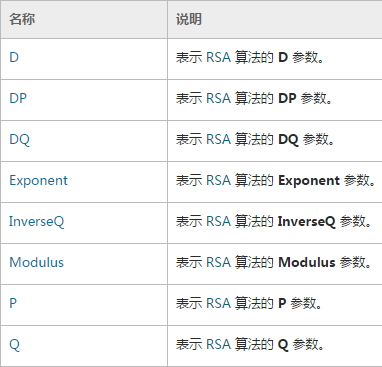RSA 算法学习笔记及 C# 公钥解密实现
事情的起因是:友商提供的接口验签方式是用他们的公钥解密一段 RSA 加密的字符串然后和明文进行相等比较。
然而 .Net 并不提供 RSA 公钥解密算法实现,在 MSDN 里明确指出Encrypt只能用公钥,Decrypt用私钥,SignData也用私钥,那么VerifyData或者VerifyHash自然就只能用公钥;最后,实例化密钥用的RSAParameters结构要么从 XML 导入,要么手动给以下属性赋值(顺便提一句,这些属性全都是二进制数组):


当时花了挺长时间学习实现了一段公钥解密代码,今天友商提供了之前不支持的 2048 位密钥,在数二进制的时候发现自己忘得差不多了,于是就整理一下写下来。
RSA 算法原理
这一节的内容主要来源于 阮一峰:RSA算法原理(二)。
请尝试计算下面两个式子:
(65^17)%3233 // 65 的 17 次方对 3233 求余
(2790^2753)%3233 // 2790 的 2753 次方对 3233 求余
一般的计算器比较困难,不过我们有天生支持大整数的 python:
>>> divmod(pow(65,17),3233)
(2041368261935227977399887995L, 2790L)
>>> divmod(pow(2790,2753),3233)
(1732<此处省略9475位数字>1695L, 65L)
一开始的 65 经过了和 17、3233 的运算,得到余数 2790;然后 2790 和 2753 以及又一个 3233 的运算,又回到了 65。这就是 RSA 的原理。
不要急着动粗。你猜的对,这个论述省略了很多东西。
首先是定义和名字
在 17,3233,2753 这三个数中:
- 3233(算法中符号是 n,此后同)是任意选取的两个质数 61(p) 和 53(q) 的乘积;
- 17(e) 是介于 1 和 (61-1)*(53-1)=3120 之间,并且和 3120 互质的一个随机数;
- 2753(d) 是 17 对于 3120 的模反元素1;
在 RSA 算法 PKCS#1 的定义中:
- 17(e) 叫做 publicExponent,公钥指数;
- 3233(n) 叫做 modulus;
- 2753(d) 叫做 privateExponent,私钥指数;
那么所谓的公钥,就是 {e, n} 这一对整数,而私钥则是 {d, n}。
因式分解是很困难的
在已知 {e, n} 的情况下,想要得到 d,唯一(不一定,但反正还没有证明)的办法就是通过 n 因式分解得到 p 和 q;RSA 算法的安全性就在于保证这两个数足够大,让没有计算机能够在允许的时间成本内计算出结果。上面的例子中 3233 写成二进制是 12 位,那它就是一个 12 位的密钥,现实的应用中,使用的主要是 1024 和 2048 位的密钥;
不过说起来,好像已经有能用的量子计算机2了。不知道这次这台“万能解密机”会不会被人炸掉3。
公钥解密实现
有了上面的原理,再加上 .Net Frameworks 4.0 里已经提供了BigInteger类,看起来这个问题没有一开始那么吓人了,撸起袖子上吧:
var modulus = BigInteger.Parse(modulusString);
var exponent = BigInteger.Parse(exponentString);
var encryptBytes = Convert.FromBase64String(encryptText);
var value = new BigInteger(encryptBytes);
var result = BigInteger.ModPow(value, exponent, modulus);
var resultBytes = result.ToByteArray();
return Encoding.UTF8.GetString(resultBytes);
执行以上代码将无法得到正确结果,是因为 BigInteger 在使用字节数组初始化的时候,要求参数使用小字节序,应当进行如下修改:
var modulus = BigInteger.Parse(modulusString);
var exponent = BigInteger.Parse(exponentString);
var encryptBytes = Convert.FromBase64String(text);
Array.Reverse(encryptBytes); // 需要调整字节序,BigIntenger 需要 little-endian
if ((encryptBytes[encryptBytes.Length - 1] & 0x80) > 0) // 如果最后一个字节第一位为1,追加一个 00 避免生成负数
{
var temp = new byte[encryptBytes.Length];
Array.Copy(encryptBytes, temp, encryptBytes.Length);
encryptBytes = new byte[temp.Length + 1];
Array.Copy(temp, encryptBytes, temp.Length);
}
var value = new BigInteger(encryptBytes);
var result = BigInteger.ModPow(value, exponent, modulus);
var resultBytes = result.ToByteArray();
Array.Reverse(resultBytes); // 调整顺序
int index = Array.FindIndex(resultBytes, b => b == 0) + 1;
return Encoding.UTF8.GetString(resultBytes, index, resultBytes.Length - index); // 排除掉旋转后多余的0
这段代码勉强达到了可用标准,但还有一些缺陷:
modulusString和exponentString是从哪块石头里蹦出来的?
答:用 Java 打印的; 2. 密文太长和太短的情况下都有乱码,为什么?
答:跟密钥长度相关,具体还不知道;
由于最迫切的功能实现了,这两个问题也就一直拖了很久。
公钥内容解析
相信不少人的类库里都有一个 RsaFromPkcs8 的类,反正我身为一个代码的搬运工,最早是在支付宝给商户的示例代码里看到的,其中有一个 ConvertFromPublikcKey 方法,用于将一串 RSA 公钥字符串解析成 RSAParameters,里面有几个魔法数字:
private static RSAParameters ConvertFromPublicKey(string pemFileConent)
{
byte[] keyData = Convert.FromBase64String(pemFileConent);
if (keyData.Length < 162)
{
throw new ArgumentException("pem file content is incorrect.");
}
byte[] pemModulus = new byte[128];
byte[] pemPublicExponent = new byte[3];
Array.Copy(keyData, 29, pemModulus, 0, 128);
Array.Copy(keyData, 159, pemPublicExponent, 0, 3);
RSAParameters para = new RSAParameters();
para.Modulus = pemModulus;
para.Exponent = pemPublicExponent;
return para;
}
有了上面的基础知识,我们已经知道了公钥里有两个整数,分别是 modulus 和 publicExponent,这段代码赋值给 Modulus 属性是个长度 128 的字节数组,那就是说这段代码针对的是 128*8=1024 位的密钥。道理我都懂,可魔法数字到底是哪来的?
本来我是不需要知道答案的。但随着友商的增多,出现了 512 位的密钥,这个方法理所应当地报错了,因此必须修改代码支持 512 和 2048 位的公钥。
PKCS#1 中规定了 RSA 的公私钥格式,在 PKCS#8 中,规定了 Apache 读取证书私钥的标准。公钥使用 ASN.1 编码,感谢兔子窝:C#与Java的RSA(2)这篇文章(咦,为什么又是2…),照着他完成了 512 和 2048 位密钥的硬编码:找到03(BIT STRING)后的30(SEQUENCE)后的02(INTEGER),再读取 INTEGER 节指定的字节长度(注意区分长形式和短形式),跳过开头的00后面的数据就是公钥的 modulus,而 publicExponent 是同理下一个整数;于是,我们就得到了……更多魔法数字!
private static RSAParameters ConvertPublicKey(string pemPublicKey)
{
byte[] keyBytes = Convert.FromBase64String(pemPublicKey);
byte[] modulus;
switch (keyBytes.Length)
{
case 94: // 64×8=512位密钥固定长度
modulus = new byte[64];
Array.Copy(keyBytes, 25, modulus, 0, modulus.Length);
break;
case 162: // 128×8=1024位密钥固定长度
modulus = new byte[128];
Array.Copy(keyBytes, 29, modulus, 0, modulus.Length);
break;
case 294: // 256×8=2048位密钥固定长度
modulus = new byte[256];
Array.Copy(keyBytes, 33, modulus, 0, modulus.Length);
break;
default:
throw new NotSupportedException("不支持的公钥长度");
}
byte[] publicExponent = new byte[3];
Array.Copy(keyBytes, keyBytes.Length - 3, publicExponent, 0, 3); // 都是 65537
return new RSAParameters { Modulus = modulus, Exponent = publicExponent };
}
好消息是这段代码写完,就可以抛弃上一节的 modulusString 和 exponentString 了;以及我终于知道密钥的真实长度是什么了,因此密文过长的问题也一并解决了:
/// <summary>
/// RSA 公钥解密
/// </summary>
/// <param name="text">密文</param>
/// <param name="pemPublicKey">Base64编码公钥文本</param>
/// <returns></returns>
public static string Decrypt(string text, string pemPublicKey)
{
var publicKey = ConvertPublicKey(pemPublicKey);
return Decrypt(text, publicKey);
}
/// <summary>
/// RSA 公钥解密
/// </summary>
/// <param name="text">密文</param>
/// <param name="publicKey">公钥</param>
/// <returns>解密后明文</returns>
public static string Decrypt(string text, RSAParameters publicKey)
{
var encryptBytes = Convert.FromBase64String(text);
string result = string.Empty;
var modulus = ConvertBigInteger(publicKey.Modulus);
var exponent = ConvertBigInteger(publicKey.Exponent);
int i = 0;
while (i < encryptBytes.Length)
{
// 密文长度必须小于密钥长度
var temp = new byte[Math.Min(encryptBytes.Length-i, publicKey.Modulus.Length)];
Array.Copy(encryptBytes, i, temp, 0, temp.Length);
// 分段解密并连接
result += Decrypt(temp, exponent, modulus);
i += temp.Length;
}
return result;
}
/// <summary>
/// RSA 解密
/// </summary>
/// <param name="encryptBytes"></param>
/// <param name="exponent"></param>
/// <param name="modulus"></param>
/// <returns></returns>
private static string Decrypt(byte[] encryptBytes, BigInteger exponent, BigInteger modulus)
{
var value = ConvertBigInteger(encryptBytes);
// 密文 ^ publicExponent % modulus = 原文
var result = BigInteger.ModPow(value, exponent, modulus);
byte[] resultBytes = result.ToByteArray();
resultBytes = resultBytes.TakeWhile(b => b != 0).ToArray(); // 排除掉尾部的空数据
Array.Reverse(resultBytes); // 调整字节序
return Encoding.UTF8.GetString(resultBytes);
}
/// <summary>
/// 字节数组转换为大整数
/// </summary>
/// <param name="originBytes"></param>
/// <returns></returns>
private static BigInteger ConvertBigInteger(byte[] originBytes)
{
Array.Reverse(originBytes); // 需要调整字节序,BigIntenger 需要 little-endian
if ((originBytes[originBytes.Length - 1] & 0x80) > 0) // 如果最后一个字节第一位为1即负数,追加一个 00 避免错误
{
var temp = new byte[originBytes.Length];
Array.Copy(originBytes, temp, originBytes.Length);
originBytes = new byte[temp.Length + 1];
Array.Copy(temp, originBytes, temp.Length);
}
return new BigInteger(originBytes);
}
以上是 C# 公钥解密 RSA 的完整算法实现。谢谢大家,Fuck 微软。